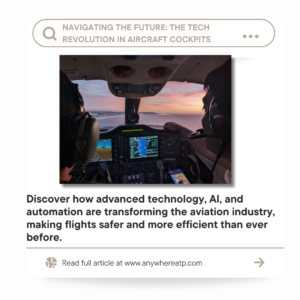
NAVIGATING THE FUTURE: THE TECH REVOLUTION IN AIRCRAFT COCKPITS
The aviation industry has always been at the forefront of technological innovation. From the early days of flight, where rudimentary controls and basic instruments were the norm, to today’s advanced avionics and state-of-the-art navigation systems, the evolution of aircraft cockpits is a testament to the relentless pursuit of safety, efficiency, and performance. As we navigate the future, it’s clear that the tech revolution in aircraft cockpits is transforming how we fly.
The Evolution of Cockpit Technology
Early Beginnings
In the early 20th century, aircraft cockpits were simple, often consisting of basic flight instruments such as altimeters, airspeed indicators, and compasses. Pilots relied heavily on visual cues and manual controls to navigate and operate their aircraft. Communication with ground control was limited, and navigation was primarily based on visual landmarks and rudimentary radio beacons.
The Jet Age
The advent of the jet age in the 1950s brought significant advancements in cockpit technology. The introduction of radar, more sophisticated navigation systems, and the first autopilots revolutionized flight operations. Jet engines allowed for higher speeds and altitudes, necessitating more advanced instruments and controls. The era also saw the development of more reliable communication systems, enabling better coordination between pilots and air traffic controllers.
The Digital Revolution
Glass Cockpits
The most significant leap in cockpit technology came with the advent of the glass cockpit in the late 20th century. Glass cockpits use digital displays to present flight information by replacing traditional analog dials and gauges. These displays, often LCD or LED screens, provide a more comprehensive and easily readable view of critical flight data, including navigation, engine performance, and weather conditions.
Glass cockpits have numerous advantages. They reduce pilot workload by consolidating information and presenting it in a more intuitive format. The ability to customize displays to show relevant data for different flight phases enhances situational awareness. Additionally, glass cockpits are lighter and more reliable than their analog predecessors, contributing to overall aircraft efficiency.
Fly-By-Wire Systems
Another groundbreaking development is the fly-by-wire (FBW) system, which replaces traditional mechanical flight controls with electronic interfaces. In an FBW system, pilot inputs are converted into electronic signals and transmitted to the aircraft’s control surfaces via actuators. This allows for more precise control and the implementation of advanced flight control laws, enhancing safety and performance.
FBW systems also enable the integration of automated flight control functions, such as auto-throttles and auto-land capabilities. These features improve operational efficiency and reduce the likelihood of pilot error during critical flight phases.
The Present and Future of Cockpit Technology
Enhanced Situational Awareness
Modern cockpits are equipped with an array of technologies designed to enhance situational awareness. Synthetic Vision Systems (SVS) and Enhanced Vision Systems (EVS) provide pilots with a clear view of the terrain and runway, even in adverse weather conditions or at night. These systems use a combination of GPS data, infrared cameras, and radar to create a real-time, three-dimensional view of the aircraft’s surroundings.
Advanced Navigation and Communication
Satellite-based navigation systems, such as the Global Positioning System (GPS) and the Wide Area Augmentation System (WAAS), have revolutionized how aircraft navigate. These systems provide highly accurate position data, enabling precise navigation and approach procedures. Additionally, datalink communication systems, such as Controller-Pilot Data Link Communications (CPDLC), streamline communication between pilots and air traffic controllers, reducing radio congestion and enhancing safety.
Artificial Intelligence and Automation
The future of cockpit technology lies in the integration of artificial intelligence (AI) and advanced automation. AI has the potential to assist pilots in decision-making by analyzing vast amounts of data and providing real-time recommendations. For instance, AI can help optimize flight routes for fuel efficiency, predict maintenance needs, and even assist in emergency situations.
Automation continues to advance, with the development of autonomous and semi-autonomous flight systems. While fully autonomous commercial flights are still a topic of debate, the incremental adoption of automation in specific flight phases, such as cruise or approach, can significantly enhance safety and efficiency.
Connectivity and Data Analytics
The connected cockpit is another emerging trend, with aircraft increasingly equipped with high-speed internet connectivity. This allows for real-time data exchange between the aircraft, airline operations centers, and maintenance teams. Predictive maintenance, enabled by data analytics, can help identify and address potential issues before they become critical, reducing downtime and operational costs.
Conclusion
The tech revolution in aircraft cockpits is an ongoing journey, marked by continuous innovation and improvement. From the early days of analog instruments to the sophisticated digital systems of today, each advancement has contributed to making aviation safer, more efficient, and more reliable. As we look to the future, the integration of AI, advanced automation, and connectivity promises to usher in a new era of aviation, where pilots are empowered with unparalleled tools and capabilities. Navigating the future, it’s clear that the sky is not the limit, but just the beginning.
© 2024.Anywhereatp, LLC all rights reserved
Number of seats
Category ATP CTP




